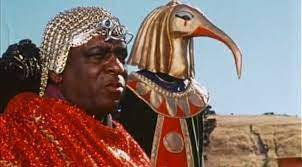A Radical Reclamation of Identity for Busy Black Parents
“Dad, imagine if our house was a temple or museum, like an archive of family history and black history and all the family members had to come here to remember… we'd probably have lots of reunions, don't you think?”
~Kyrha-Joy Pessoa
In the cacophony of modern life, where the rhythms of survival often drown out the whispers of heritage, the act of crafting a home that reverberates with the echoes of Africa is not merely an aesthetic endeavor. It is an act of resistance, a quiet rebellion against the erasure of our stories, our struggles, and our triumphs. For the Black Jamaican parents and Rasta parents navigating the labyrinth of contemporary existence, the home becomes more than a shelter—it transforms into a sanctuary of memory, a living testament to the resilience of a people who have endured, adapted, and thrived against the weight of history.

To infuse the spirit of Africa into the fabric of our daily lives is to reclaim what has been stolen, distorted, or buried. It is to say to our children, in every corner of our homes, *this is who you are, this is where you come from, and this is why it matters.* It is to create a space where history is not a distant relic but a vibrant, breathing presence. Here, then, are some ways to weave the threads of African heritage into the tapestry of your home, transforming it into a space that is both deeply personal and profoundly political.
---
My Experiences Growing Up in African Aesthetic
"A people without the knowledge of their past history, origin, and culture is like a tree without roots."
– Marcus Garvey
I was born in 1981 in Montego Bay, Jamaica, into a world where the echoes of Africa were never distant, where my childhood was shaped by the rhythms, the philosophy, and the aesthetics of a continent I had never seen but always felt. My grandmother, a proud woman deeply rooted in the teachings of Marcus Garvey’s UNIA, carried the fire of Pan-Africanism in her bones. My parents, too, carried that torch, ensuring that I never grew up believing the lie that Christopher Columbus had “discovered” Jamaica. History, for us, was not something to be dictated by colonial narratives—it was something we reclaimed.
They named me Yannick, after the great Yannick Noah, his spirit of defiance and triumph a fitting aspiration. My middle name, Nesta—perhaps Nestor, depending on which parent you asked—was a reflection of their indecision between a Bob Marley tribute or a nod to the Greek sage of wisdom. But what was clear, beyond any name, was the foundation they laid for me: a childhood steeped in African identity, even while standing on Jamaican soil.
Reggae was the heartbeat of our home, but alongside Bob, Peter, and Bunny, there were the haunting harmonies of Miriam Makeba, the triumphant horns of Hugh Masekela, and the layered rhythms of Ladysmith Black Mambazo. Graceland by Paul Simon played often, its African sonic aesthetic blending seamlessly with the reggae basslines that framed my childhood. And then there was The Police—a band that, though not African, carried echoes of that same percussive heartbeat in songs like Walking on the Moon. Music wasn’t just entertainment; it was an education, a bridge to a world that was stolen from us yet never truly lost.
On television, I watched Roots and Shaka Zulu, their dramatized retellings of our history igniting a fire in me—an anger, yes, but also a deep pride. The Cosby Show gave me a different kind of Black excellence, a vision of success and family life that felt both aspirational and affirming. But it was the small things, the everyday aesthetics, that shaped my consciousness most: the wooden figurines with nappy hair that stood proudly on our shelves, hair kinkier than mine, challenging the beauty standards imposed by colonialism. I longed to be closer to that aesthetic, to see in myself the reflection of those figurines, of those ancestors.
In 1980s Jamaica, embracing an African identity was both nostalgic and radically forward-thinking. The country itself was in flux—politically, culturally—straddling the lingering shadows of colonial influence and the fiery resistance of the post-independence generation. While many still clung to European ideals, my family stood firm in the belief that looking back to Africa was the only way to move forward. It wasn’t just a romantic notion; it was a way of life. One that shaped me, one that still lives in me.
---
The Radical Power of Everyday Objects: Tea Towels as Cultural Artifacts
In a world that often reduces African identity to a monolith, the act of reclaiming the mundane—of turning the ordinary into the extraordinary—becomes a radical gesture. Consider the humble tea towel, an object so often relegated to the drudgery of domestic labor. In the hands of a Pan-African parent, it becomes a canvas for cultural expression, a silent yet potent declaration of identity.
Seek out tea towels adorned with Adinkra symbols, those intricate Ghanaian emblems that carry within them the wisdom of generations. Each symbol—be it *Sankofa*, urging us to return and retrieve what has been lost, or *Gye Nyame*, proclaiming the supremacy of the divine—becomes a lesson, a mantra, a reminder of the values that have sustained us. Or perhaps opt for the bold, geometric patterns of Ndebele art, a visual language that speaks of resistance and resilience. These towels, draped over oven handles, hung in bathrooms, or framed as art, are not mere decorations. They are fragments of a larger story, one that refuses to be silenced.
---
Walls That Speak: The Politics of Wall Art
The walls of a home are never neutral. They are the silent witnesses to our lives, the blank slates upon which we inscribe our identities. For Black parents, these walls can become a powerful medium for storytelling, a way to assert our presence in a world that often renders us invisible.
Choose wall art that speaks to the complexity and richness of African heritage. Bold, abstract designs that echo the rhythms of the continent; portraits of figures like Marcus Garvey, Wangari Maathai, or Chinua Achebe, whose lives and works remind us of the power of resistance and imagination. Seek out the works of local Black artists, whose creations are not only beautiful but also imbued with the urgency of lived experience. By supporting these artists, you are not just decorating your home—you are participating in a larger ecosystem of cultural preservation and economic empowerment.
Consider, too, the use of African masks, those enigmatic objects that carry within them the spirits of ancestors and the wisdom of traditions. But be mindful: these are not mere ornaments. Each mask has a story, a meaning, a context. Take the time to learn these stories, to share them with your children, to make them part of the living narrative of your home.
---
Textiles as Text: Weaving Culture into Comfort
Fabric is more than material; it is memory, it is meaning, it is metaphor. The vibrant colors and intricate patterns of African textiles are not just visually striking—they are carriers of history, each thread a testament to the ingenuity and creativity of a people.
Kente cloth, with its kaleidoscope of colors and patterns, is more than a fabric—it is a language. Each design carries a message, a proverb, a piece of wisdom. Use it to adorn your sofas, your beds, your chairs, turning everyday objects into vessels of cultural significance. Mud cloth, with its earthy tones and geometric designs, offers a different kind of beauty—one that is grounded, organic, and deeply connected to the land from which it comes.
But remember: these textiles are not just decorations. They are artifacts, each one a piece of a larger story. When you bring them into your home, you are not just adding color or texture—you are adding depth, meaning, and history.
---
Sculptures as Statements: The Power of Three-Dimensional Art
In a world that often reduces African art to the exotic or the primitive, the act of incorporating African sculptures into your home becomes a radical act of reclamation. These are not mere objects; they are embodiments of history, culture, and identity.
Bronze figurines that depict historical figures or everyday scenes; wooden carvings that capture the essence of African spirituality; calabash bowls that speak of the ingenuity of traditional craftsmanship—each of these objects carries within it a story, a meaning, a connection to the past. Place them on your shelves, your mantels, your tables, and let them serve as reminders of the richness and complexity of African heritage.
But be mindful of their placement. These are not just decorations; they are focal points, conversation starters, pieces of art that demand to be seen, to be understood, to be appreciated. Take the time to learn their stories, to share them with your children, to make them part of the living narrative of your home.
---
A Home as a Living Archive
Designing a home that honors African heritage is not about following a set of rules or adhering to a particular aesthetic. It is about creating a space that reflects your identity, your values, your history. It is about finding objects that resonate with you, that tell your story, that connect you to your roots.
Be bold. Be creative. Mix and match traditional and contemporary pieces. Use color, texture, and pattern to create a space that is uniquely yours. But above all, remember that this is not just about decoration. It is about reclamation, resistance, and resilience. It is about creating a home that is not just a shelter, but a sanctuary—a place where your children can learn, grow, and thrive, surrounded by the beauty and power of their heritage.
In the end, the home you create is not just a reflection of who you are—it is a statement of who you can be. It is a testament to the power of memory, the importance of history, and the enduring strength of a people who have always found ways to survive, to adapt, and to thrive. And in that, it is nothing short of revolutionary.
*Yannick Nesta Pessoa B.A. is Jamaica’s first blogger, a Social Advocate, Community Activist, Artist, and Philosopher. Follow me on Twitter & Instagram @yahnyk, on YouTube, and reply to yannickpessoa@gmail.com.*
Now, go pour yourself a glass, fire up YouTube, search for African decor ideas and let the ideas flow. Happy Friday, and happy Black History Month. ❤️





























.png)

.png)